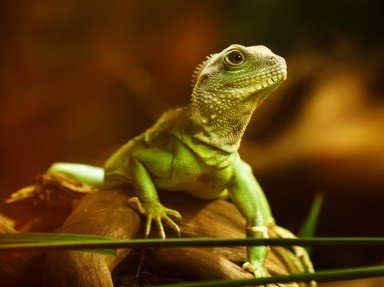Quiz Answer Key and Fun Facts
1. Our first picture shows 'Intellagama lesueurii', one of more than 300 species in the 'Agamidae' family of Igunaian, mostly-arboreal Old World lizards. By what mythical-sounding name is this species and many members of this family generally known?
2. The lizard pictured here is native to the Arabian Peninsula, mostly in Yemen and Saudi Arabia. One of more than 200 species in a distinctive and highly specialized family of Old World lizards, their physical characteristics long, rapidly extrudable tongues, a swaying gait and crests or horns. By what name are members of this family generally known?
3. Pictured here is 'Basiliscus basiliscus', the common basilisk, which is native to the rainforests of Central and South America. This is one of nine New World Iguanian lizard species in the 'Corytophanidae' family. By what common name are members of this family generally known?
4. The pictured 'Gambelia sila' is an endangered Californian species now found only in the San Joaquin Valley region. One of three species in the 'Gambelia' genus, it is part of the 'Crotaphytidae' family of desert-dwelling, carnivorous, North America natives. By what name is this and other members of the 'Gambelia' genus generally known?
5. The pictured species, sometimes called a mountain boomer, is a North American native known particularly for its ability to run on its hind legs. This is one of the nine species in the 'Crotaphytus' genus that makes up the other half of the 'Crotaphytidae' family. Indigenous to southwestern parts of the USA and northern Mexico, by what name are this and other members of the genus known?
6. The pictured 'Amblyrhynchus cristatus' is one of a handful of lizard species found only on the Galapagos islands. It can be seen in the marshes and mangrove swamps but is usually seen basking on the rocky shoreline since it is the only modern lizard capable of foraging in the sea. This species and other members of its genus are generally known by what name?
7. This is 'Sceloporus magister', a native of North America's Chihuahuan and Sonoran Deserts. This is one of more than 90 species in the 'Sceloporus' genus, which includes some of the most commonly-seen lizards in the USA. By what general name are this and other members of the genus known?
8. This is 'Phrynosoma solare', a native of Mexico and the southwestern USA. It is one of around 15 American natives in the 'Phrynosoma' genus. Although members of this genus sport some impressive arrays of spikes all over their body, their main defence against predators is the ability to squirt blood from its eyes! By what name are this species and other members of its genus known?
9. The pictured lizard is widespread across the Caribbean island nation of Saint Lucia and is one of 391 species in the 'Dactyloidae' family. This is the largest (in terms of number of species) of all families of four-legged amniotes. By what name are the pictured species and other members of the family known?
10. Active primarily at twilight, 'Eublepharis macularius' is a ground-dwelling lizard native to the desert regions of Pakistan and northern India. They are part of a large family of more than 1,500 species, the most in any lizard family, that uniquely use chirping sounds to communicate with each other. By what name of species in this family generally known?
Source: Author
EnglishJedi
This quiz was reviewed by FunTrivia editor
Tizzabelle before going online.
Any errors found in FunTrivia content are routinely corrected through our feedback system.

